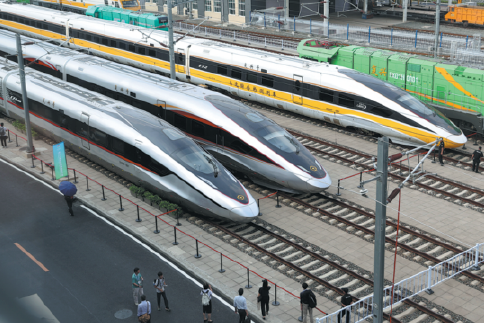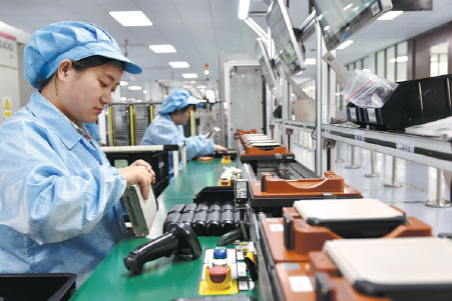'Little giant' firms in China bring fresh economic impetus


BEIJING -- At a factory laboratory in suburban Beijing, workers are pouring a milk-white substance into a starch fermentation cylinder. About 40 hours later, germs in the tank will give birth to a mass of powder that can be used to make biodegradable plastic film.
"In those bacterial colonies, each cell forms a super factory," said Chen Guoqiang, a Tsinghua bioengineering professor and the founder of PhaBuilder, a startup using microbes to churn out high-value-added industrial raw materials.
The work conducted at PhaBuilder is typical of the country's emerging industrial landscape, where a host of tech-intensive Chinese startups have sprung up, acting as the new engines of economic growth.
These innovation-driven small and medium-sized enterprises, which own core technologies in a niche market and show great market potential, are known as "little giants." According to a recent official survey, the Ministry of Industry and Information Technology places more than 10,000 enterprises in China in the "little giant" category.
As of late July, over 3,600 newly-certified little giants, of which 86 percent are privately-owned, had obtained about 175,000 patents, according to a Beijing industry institute. The research and development (R&D) intensity of these SMEs has provided them with strong earning power.
Of the 611 listed little giants that have released their half-year financial reports, more than 90 percent showed profits, according to Choice, a Chinese financial data service. Meanwhile, 428 of them had invested more in R&D, with 17 increasing their investment by over 100 percent.
Tech companies like PhaBuilder tend to be founded on the basis of years of existing laboratory work, usually originating with university research groups.
Chen's team discovered its powerful germ around a dried-out lake in northwest China's Xinjiang Uygur autonomous region in 2003. After two decades of study, the genetically-engineered species finally rolled off the line. Last year, PhaBuilder launched a synthetic biology facility at the Beijing China-German Industrial Park.
Another little giant is Acoinfo, specializing in industrial real-time operating systems. The research staff started product design in 2006, and this year their efforts paid off.
Acoinfo's SylixOS system has been installed in an ultra-high-voltage electricity transmission project that conveys renewable power from northwestern China to the country's power-thirsty eastern area.
"As the demand for home-grown technology is growing in multiple sectors, we see greater market potential in the future," said Han Hui, chairman of the Beijing-based startup.
PhaBuilder's production process dispenses with the strict sterile and high-pressure requirements of traditional chemical engineering. As such, it has reduced water and energy consumption by at least 50 percent, making the production process more cost-effective and eco-friendly.
"The production line is so streamlined," said Xu Xuanming, PhaBuilder's chairman. "That's our real strength."
Also, a chemical produced in the process has been put into space aboard Tianzhou-1, China's first cargo spacecraft, for studies on a potential medicine for osteoporosis, according to Chen.
"We are examining its role in bone formation in a microgravity environment, which may offer new possibilities for osteoporosis treatment," said Chen.
In March, a synthetic biology innovation alliance was set up by 16 enterprises and 16 research teams from 8 institutions, including Tsinghua, to facilitate the commercialization of scientific and technological achievements.
In the first half year, investment in China's service industry for scientific and technological achievement transformation grew by 46.3 percent, according to the National Bureau of Statistics.
Breaking the bottleneck
Workers at a plant in South China's Guangxi Zhuang autonomous region are producing a coating that makes glass electrically conductive. The indium tin oxide (ITO) coating is a core technology in smartphone display screens.
Guangxi is rich in indium tin, but for a long time, local manufacturers had to import the coating, which was five to eight times more expensive than the raw material, said Huang Shicheng, general manager of Guangxi Crystal Union Photoelectric Materials.
These days, thanks to various technological breakthroughs, the little giant is mass-producing ITO. Huang is proud of the advances the plant has made in powder preparation, the forming process and sintering.
"From 2016 to 2022, the sales volume of the company's products increased seven-fold," said Huang.
At a production line in Beijing, more than a hundred multiaxial electric discharge machines punch little holes in turbine blades, key components in airplane engines.
The mass production of turbine blades has been a top engineering challenge for Beijing Hanfei Aviation Technology, as the components must be able to work at 1,700 degrees Celsius. The tiny holes allow for cooling air to circulate, ensuring the blades can function in such extreme conditions.
"The single-crystal turbine blade is the source of power for aero-engines and our work is to install 'air conditioning' in the engines," said a manager at the company, pointing at a palm-sized metal part.
Hanfei Aviation overcame the technical barriers to manufacturing this sophisticated equipment, developing its own basic algorithms, industrial software, computer numerical control systems, machine tools and digital twin system.
A report on China's little giants has shown that they are highly consistent with the country's advanced manufacturing strategy, which involves new materials, next-generation IT, high-end mechanical equipment and new-energy vehicles.
"Little giants account for 2 percent of small and medium-sized enterprises above a designated size nationwide, but they contribute five percent of earnings and nearly 10 percent of profits," said Liang Zhifeng, an official with the MIIT.





































